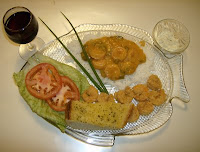This
Baked Shrimp with Lemon-Garlic Butter recipe is so simple to prepare and VERY delicious, too... especially when using
Wild White Gulf of Mexico Shrimp, which are known worldwide for their sweet and succulent flavor.
 |
| 16/20 Count Wild White Gulf of Mexico Shrimp |
I prefer to use a regular cookie tray like a
Wilton 15.25" x 10.25" x 1" when preparing this Cajun favorite. It's a perfect pan because it can hold enough cooked shrimp to serve more than just a couple folks at a dinner party (unless, of course, you invite one of my Cajun relatives).
Try it next time when you get the chance. If you are a shrimp lover like me, I know you will absolutely love this delicacy.
Just recently I purchased several pounds of the 16/20 count
Wild White Gulf of Mexico Shrimp from my supplier, CajunGrocer, in Lafayette, Louisiana. I am here to tell you cher, that they are the best that money can buy and you don't have to spend a fortune to buy 'em.
Most of the time I try to order my gulf white shrimp with the heads on because believe or not, they are less expensive with the heads on, and I get a much bigger bang for my buck because I use the heads to make a broth, which I then include in special meals like seafood gumbo. It's excellent for other dishes, too -- like etouffee, piquant, and jambalaya.
I also use shrimp broth in some batter/coating recipes for frying catfish nuggets, oysters, and other seafood. When I am finished boiling and extracting all of the flavors from the heads, I bury them in my garden to feed my vegetables. Nothing wasted! It becomes an excellent fertilizer. Everything has been recycled. And, that's good.
One other thing... the larger the better. When I can get the 9-12 count of gulf whites, I get even more use from the shrimp heads because they are large enough, at that size, to contain a fair amount of meat.
I like to call it the rib-eye of large shrimp. Just pry apart the top portion of the heads from the bottom, clip the legs off with kitchen shears, wash under cool running water, dredge them in your favorite tempura batter and deep-fry at 365 degrees F. for about 3 minutes. It tastes amazingly like freshly fried soft shell crab.
If you would like to take a gander at the latest prices on
Gulf of Mexico Wild White Shrimp you can visit my favorite supplier by using this link:
Cajun Grocer.
It takes just 2 or 3 days [ground] to get your order delivered to your door. The shipping rates are reasonable. Your shipment is packed in dry ice and these extra-large shrimp are individually quick frozen (IQF) -- which means you can remove as many as you want individually, without having to thaw the entire bag.
It takes about 20 minutes, or so, for IQF shrimp to thaw out. Use cool water. Once they are thoroughly thawed remove the heads from the body and make your shrimp broth before discarding the heads.
The amount of water that you use will determine the strength of the broth. I also like to add the shrimp shells to my broth preparation because it offers even more overall flavor.
Note: You may want to use just a tiny bit of salt when preparing the broth to help extract the flavors from the heads and shells, but not too much if you plan to use the discarded refuse as fertilizer for your vegetable garden.
Adding too much salt in the preparation of the broth will affect the soil and consequently the growth of your garden plants if you decide to use it as fertilizer.
If you have any questions please leave them in the comment section below and I will be glad to answer them.
Ingredients
- 2 lbs. of 16/20 count Wild White Gulf of Mexico Shrimp, peeled, deveined and butterflied to the tail (leave tails on)
- 1/4 lb. melted butter (or 1 stick)
- 1/4 cup dried oregano or Italian seasoning (your choice)
- 1 large lemon, squeeze the juice out for later use then cut into thin slices
- 2 tsp. of Old Bay with Garlic & Herb Seasoning
- 1 tsp. salt
Instructions
- combine the melted butter. lemon juice and seasoning into a 2-quart bowl
- whisk all of the ingredients well for a few seconds
- add the peeled shrimp and mix together gently and coating thoroughly
- top the cookie tray with heavy duty aluminum foil
- layer the top of the foil evenly with lemon slices
- add the shrimp on top of the lemon slices until the entire tray is filled
- place tray midway in a preheated 350-degree oven and cook for 12 -15 min.
Voila! Simple and delicious! An excellent hors d'oeuvres for your lucky guests.
Bon appetite!... Ummm... C'est Magnifique!




















 About
About Tags
Tags Popular
Popular








